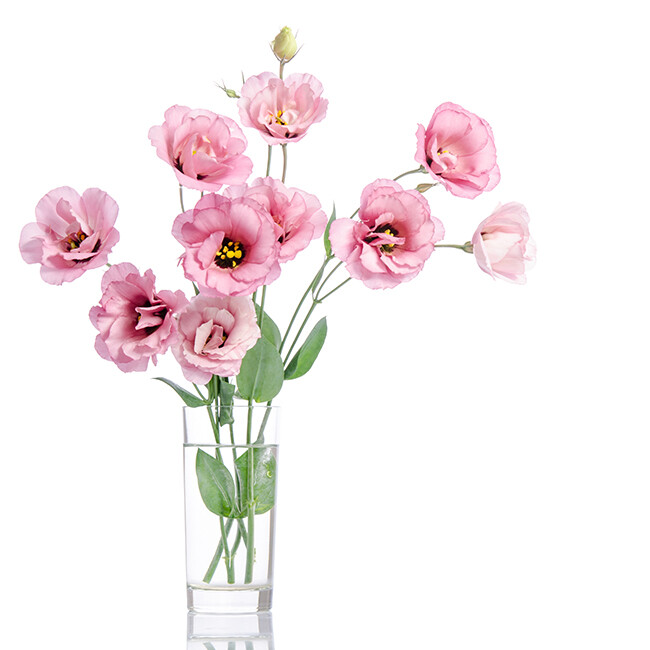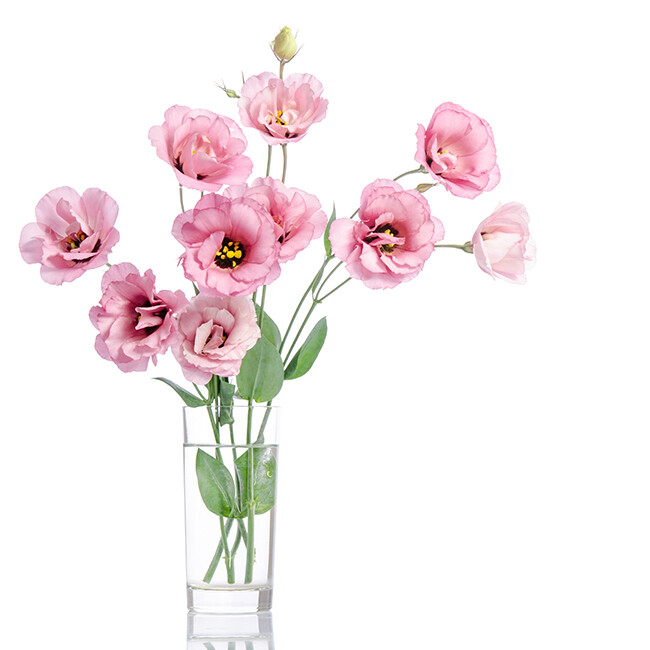
This particular species of plant, often called Eustoma, originates from North America and is native to both prairie regions and desert riverbeds.
Due to this, many refer to it as the ‘prairie gentian’, particularly in the states of Nevada, Texas, Nebraska, and Colorado. In the 1930s, Japanese growers crossed the prairie gentian, creating the Lisianthus species we see today.
In literal terms, Lisianthus means ‘bitter flower’ and was given the name to the taste of the flowers which we traditionally used in herbal medicine.
So, if you want to brighten up your garden with a beautifully colored flower then follow the tips and tricks below.
The Lisianthus’ shapes and hues
With an array of colors, styles, and types to choose from, there is surely a Lisianthus plant to suit all. From green and white variants to blue, pink, salmon, purple and lilac shades, there are multiple colors available. Certain species even boast flowers with petals brandishing several shades.
In addition to this, the Lisianthus plant boasts many styles, including single and double-flowered variants, with large and small blooms, whilst some also have fringed petals. To top this off, new species and shapes are constantly being discovered, all with soft and delicate petals.
You can recognize a Lisianthus because of their long, slender stems, which bear several gentian-like tubular flower heads.
How can you ensure growth?
Depending on where you live, growing tips for Lisianthus can vary.
In areas where temperatures can drop to freezing, it’s important to plant them post frost. In warmer, southern climates, however, you can plant this type of plant as early as March. If you can, try to plant as early as possible. Most green-fingered connoisseurs will know that Lisianthus are extremely slow growing plants.
In addition to planting these flowers at the correct time of year, you will also need to adopt some serious weed management. This particular specie of plant stays relatively small for several months, with the leaves protruding from the base of the plant in the shape of a rosette. Because of this, aggressive weeds, such as crabgrass and creepers, can rapidly destroy Lisianthus plants.
Rosetting is when the plant doesn’t flower but instead yields a gathering of leaves. This happens because of the poor lighting conditions, the incorrect temperature, and too much or too little water.
Once this happens, it is extremely difficult to reverse. In some cases, however, lowering the temperature to 10°C for roughly 30 days will help.

What do you need to look out for?
In order to counteract the build-up of pests and pathogens in the soil, it’s important to introduce crop rotation. The most common pests to attack Lisianthus include leaf miners, thrips, aphids and whiteflies.
Lisianthus is also prone to fusarium, botrytis, and various other diseases, all of which require research in order to prevent them.
Due to Lisianthus staying small for many months after planting, aggressive weeds, such as crabgrass can quickly overtake the plant and smother them.
How to look after Lisianthus
For best results, prep flower beds in the spring, adding cottonseed meal, compost and green potash to the soil. Lisianthus thrives particularly well in clay soil, as it’s able to hold water without staying wet. This is important, as Lisianthus plants require excellent drainage and soil with a pH that sits between 6.5 and 7.0.
When it comes to watering Lisianthus, one tip involves doing so when the top two inches of soil has dried. Avoid watering your plant when the weather cools, this is usually when the plant stops flowering, as Lisianthus prefer dry winters. To encourage regrowth, cut flowers back when they fade – this will promote branching and re-blooming.
As a general rule, it’s a good idea to keep the soil evenly moist, without being saturated. It’s extremely important that you avoid dry soil during germination, as this is when Lisianthus require the most moisture in order to dissolve the pellet coat surrounding the seed.
During the germination period, which takes between 10–15 days, you must keep temperatures at 21–24°C. on top of this, you must provide your plants with good air circulation. Be careful when covering seeds and small plants with clear or white plastic domes, as asides from providing consistent moisture and heat levels, they can also promote excess moisture. This can generate mold. For best results, remove the domes prior to the seeds germination and invest in a fan, as these can be used to increase ventilation.
Transplanting seedlings
Seedlings can be very slow to grow; some require 60 days before being transplanted. When you see the first signs of life, place seed trays in an environment that boasts good air circulation.
To avoid algae growth, lower moisture levels and allow the soil to dry slightly before watering the plants. Any tip for best results involves avoiding extreme humidity and low light levels.
Types of Lisianthus
The main species of Lisianthus include the Texas bluebell, Prairie Gentian, Tulip gentian, and Lira de San Pedro.
These long-stemmed flowers boast blue and purple hued petals, with a fuse at the base. The petals look a little like funnels and are slightly trumpet-shaped, with a hint of yellow on the inside. The stamens of the Lisianthus boast long and slightly twisted anthers, which sit close to the base of the petals. When grown in the garden, they typically reach a height of 18-30 inches, although dwarf varieties are now readily available, and grow between 6 and 8 inches tall.
Harvest period
There are many different species of Lisianthus available today, many of which are able to thrive in different climates and growing seasons. Due to these changing conditions, it is a must that you select the correct variant and one that has been bred to perform for your required harvest period. By following this simple rule, you will guarantee the maximum stem length for both your growing season and climate.
Grow in a protected environment
If you’re unable to grow Lisianthus plants outdoors, you may wish to grow them in the greenhouse or another protected construction. This will allow you to shelter the flowers from wind, rain, frost and various elements. All of these elements can prevent growth and in some cases, cause damage. For example, rain can produce spots on the petals.
Of course, it’s equally important to protect flowers grown in greenhouses, as even water droplets caused by condensation can cause ailments. When picking species of Lisianthus, it’s a good idea to do your research – darker flower hues are more inclined to showcase spotting than lighter colors.

How to care for your Lisianthus (indoors)
There are a number of tips and tricks to follow if you wish for a healthy, thriving plant, but in general, the Lisianthus is one of the easiest flowers to look after.
If you are placing them indoors, start by choosing a clean vessel and fill with water at room temperature.
Once you have a vase in place, add flower food to the water – this is a must if you wish to prolong the vase life of Lisianthus.
Trim the stems diagonally using a clean, sharp knife or secateurs, 3 to 5 cm should suffice.
Make sure no leaves are submerged in the water.
Place in an environment out of full sunlight, away from drought and central heating.
Keep an eye on the water level of the vase and top it up when it becomes low; Lisianthus flowers tend to drink a lot of water because of their thin petals, which evaporate a lot of moisture.
Avoid placing your Lisianthus flowers near a fruit bowl. The ethylene gas emitted by fruit can cause the flowers to age more rapidly.
Creating the perfect bouquet
The lisianthus is an incredibly versatile flower. You can use them in bouquets, table centers, wire the flowerheads for buttonholes and headdresses, and also keep the long stems and tight flower buds to create a free look to an arrangement.
Due to its exceptional vase life, Lisianthus is regarded as a very prevalent, high-end cut flower, particularly because of its rose-like appearance.
These picture-perfect flowers complement an array of other blooms, which makes them a great option for a bouquet. Cotinum, rosehips, anthurium, and blackberries are just a few of the prevalent species many florists choose to combine with Lisianthus flowers.
If placing outdoors, however, choose a rugged terracotta pot for best results, and place next to subtle borders, pastel shades, and romantic shapes.
Lisianthus symbolism
Although delicate and soft-hued in style, Lisianthus flowers boast powerful symbolism. This floral specie represents charisma, appreciation, and gratitude, although previously the flowers were linked more closely to feelings of romantic desire.
This very symbolism is the reason many choose to gift this bouquet to a loved one. From the perspective of astrology, these beautiful floral blooms are a great gift for those born between November 22 and December 21, which will make them a Sagottarian.